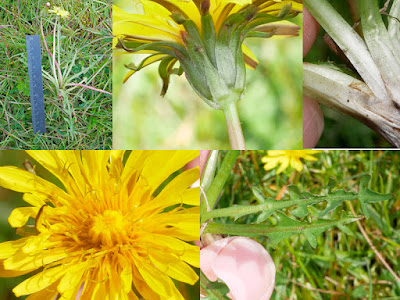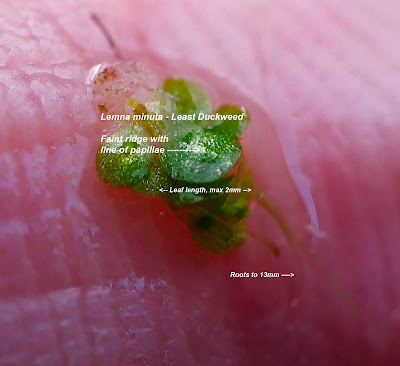As I write this near the end of April, it has been a cold, mostly wet month overall with only glimpses of Spring sunshine and never more than a few days without cloud and rain. However, the plants respond mostly to increasing daylight hours and not just temperature, so more and more species are coming into flower every week. Here's a selection of those flowering here this April.
Goldilocks Buttercups are rare in Cornwall and are found in old woodlands, so it was nice to see it at a known site near Wadebridge. This is another genus where there are many microspecies or apomictic populations. In Kent, the majority of them are scruffy and lose petals within an hour or so of opening, but here, many were intact. It seems it depends on the microspecies as to whether you find some with petals complete or not.
Ranunculus auricomus
Shepherd's Cress is a small white crucifer (related to Cabbages) and I photographed a large colony growing on a Cornish hedge near Dozmary Pool on Bodmin Moor. Unfortunately, I only had my phone with me to capture the moment.
Teesdalia nudicaulis
Thyme-leaved Sandwort has a very small flower and is often found in ruderal or waste areas, as was the case here near Wadebridge.
Arenaria serpyllifolia
Sticky Mouse-ear is a Spring annual, so by the end of May they''ll all be gone until next year. However, it seeds prolifically and it is a very common plant to find almost anywhere except very wet or very acidic places. An easy way to separate this from the other Mouse-ears is that the inflorescences are tightly bunched at the top of the stem. Size can range from 1cm tall to around 15cm.
Cerastium glomeratum
Anything coloured red in the sward really stands out. This is a leaf from a Shining Cranesbill plant growing on the thinnest of soils on a pavement. I think the colouring is a sign that the plant is stressed, but it still survives and has flowers. I wonder if red allows photosynthesis to occur?
Geranium lucidum
Ivy-leaved Speedwell is another here then gone Spring annual. It comes in two subspecies that are easy to tell apart if its in flower. Subspecies lucorum is usually found in shaded habitats such as woodland edges and has white or cream pollen. Subspecies hederifolia has blue pollen sacs and slightly wider leaves and prefers more open, light conditions. You'll need an eye loupe to magnify the tiny 5mm flower to see the anther colour unless you have very good eyes.
Veronica hederifolia subsp hederifolia
Following a tip off from the VC2 vice county recorder, I went to see a new species for me, Nettle-leaved Figwort. It was on the Camel Trail in Wadebridge by a smelly dog poo bin, so it's location was not at all glamorous.
Scrophularia peregrina
It looks a bit like a glossy Common Figwort, so I thought it would be handy to compare the two species, see the next photo below.
And the exotic location!
As April progressed, the Wood Anemones came into flower. They are dotted around Cornwall and found mainly in the wooded river valleys that farmers don't use. However, I haven't seen carpets of them like you get further East in other parts of England. I'm hoping to find a blue variant (var. caerulea) before the season ends, but it has eluded me so far.
Anemone nemorosa
Not far from the above Wood Anemones, I found what seems to be Barrenwort. It's a rare garden escape and looks like a Hedge Bindweed but with woody stems. It also throws up sprays of flowers in late Spring, so to firmly identify it I have to return in May and hope it flowers.
Epimedium pinnatum (unconfirmed)
Still in the same wood was a colony of around 50-100 Common Twayblade, these are also not as common in Cornwall as the rest of the UK. The flower spikes were just short of flowering on some plants. For those that don't know, this is one of the 50+ species of orchids found in the UK.
Neottia ovata
A garden escape naturalisation that I commonly see now is Fringecups. It's usually around 60cm tall with a spike of little flowers up it. This one was on a rural road verge near Wadebridge.
Tellima grandiflora
Spring is the time to find Wintercress. There are three species and the one below is American Wintercress. Check the uppermost leaves just below the flowers. If they are shovel shaped it is Common Wintercress; if there are a few side lobes with tiny flowers under 4.5mm wide then it is Intermediate Wintercress, and finally as Intermediate but with larger flowers over 4.5mm diameter you have American Wintercress. Hope that helps!
Barbarea verna
An unusual find was Stinking Hellebore, I believe it's not native to Cornwall. It was in woodland by a tiny rural lane between Camelford and Wadebridge. I'd only seen them before on chalk soils. No doubt a survivor of past fly tipping.
Helleborus foetidus
The hanging flowers of Redcurrant, quite a common plant in our woodlands.
Ribes rubrum
A trip to my local bog found Lousewort back in flower
Pedicularis sylvatica
Heath Milkwort in deep blue, small but beautiful. Found in acidic soils in dry heaths or drier parts of mires and bogs. Note the opposite leaves at the base of the stem. Common Milkwort has alternate leaves from base to tip. That's useful to know, as there are a few places where both species can be found growing not far apart.
Polygala serpyllifolia
When seen en masse, Bog Stitchwort look like tiny little white stars in the bog.
Stellaria alsine
A walk through a forestry woodland in mid Cornwall had carpets of the alien Rockery Willowherb, a recent arrival to the UK. It's spread here by forestry vehicles and plantation woodland is where it is predominantly found at present. I also found a patch of New Zealand Willowherb, another alien though neither were yet in flower. Both species hybridise with our native willowherbs and it is possible to find a hybrid species new to science. I will be back to look for them come the summer.
Epilobium pedunculare
Bilberry in flower from the same woodland as above.
Vaccinium myrtillus
It's rare that I find Blackcurrant in the wild, but it is a native species. It looks a bit similar to Redcurrant (see above), but the flowers don't hang like a curtain like Redcurrant does. Also, any doubt can be removed by gently squeezing a leaf then sniffing your fingers. If it's a Blackcurrant plant you will smell it as the leaves have glandular hairs that release this lovely scent when crushed.
Ribes nigrum
In a damp meadow I found numerous specimens of this dainty Dandelion. It was clear it was a Section Celtica species and I keyed it out to be a recently described species which was soon verified by the BSBI Taraxacum referee, a nice find. The leaves are very distinctive in this micro species.
Taraxacum chlorofugale
Cuckooflowers are common and found in damp roadsides, meadows and any damp areas really. However, it is very difficult to get a nice photo as the flowers reflect the sunlight back, usually bleaching out the details. Here, as it was so bright, I stopped the camera down to f16 which restricted the amount of light coming into the camera and gave an improved depth of field. You can only do this in good light or if using a tripod. This photo was near a lake in Bude.
Cardamine pratensis
The Fumitories are re-appearing, with this long thin flower belonging to Tall Ramping Fumitory. This variant always has a pink upper petal, matching the colour of the flower body. Other species have a black tipped upper petal, so this is an easy one to identify.
Fumaria bastardii var bastardii
Bogbean has an amazing flower structure but an ugly name. It is common over much of the UK and is found in bogs, mires, lake edges and anywhere permanently wet.
Menyanthes trifoliata
Early Meadow Grass used to be a rare species of southern coastal grassy areas, but it has now spread north to beyond the Midlands and is increasingly found in urban or brownfield sites. The one below though, was found on a path by a lake in totally natural surroundings. It can be confused with Annual Meadow Grass, the common grass of pavements and pretty much everywhere else.
It's characteristics are that the inflorescence is delicate and always pale green with no purple hues; the anthers are smaller than Annual Meadow Grass (you need magnification to measure them), and the lowest spikelet is usually at 45 degrees and not reflexed to 90 degrees or more. Look for lime green patches in short grass or bare ground.
Poa infirma
The clifftop edges on western coastlines are now exploding with the blue flowers of Spring Squill. In places you can get carpets of these tiny plants which look like miniature Spanish Bluebells. Lovely little plants.
Scilla verna
Typical habitat below
Horsetails didn't seem too complicated, until I realised that they freely hybridise. To check whether you have the true species or a hybrid, you need to cut open a stem to observe the hollow inside it. Below is Water Horsetail which is the only species that has an almost circular stem with a very large hollow, this rules out any hybrid. It's often unbranched as shown below and forms large stands in damp areas or by water bodies.
Equisetum fluviatile
Nearby were Marsh and Field Horsetail so it was worth checking for hybrid plants, but this day I failed to find any, though they had been recorded from this venue before. Below is Marsh Horsetail with small branches to the stem and a small hollow stem strongly ridged.
Equisetum palustre
Marsh Marigolds in a boggy part of a lake near Bude, they light up the bog with their golden hues. Even the seedpods are a fantastic colour.
Caltha palustris
My final plant is another Dandelion, this time from near Bude in another damp meadow. It's a Section Celtica microspecies and is fairly delicate. It keyed out in the Field Handbook as Taraxacum nordstedtii as there appeared to be pollen present.
However, since writing this, I have been notified by the BSBI referee that this is in fact Taraxacum pietii-oosterveldii and is new to Cornwall. The nearest known colony is on Dartmoor. The pollen is not on the anthers and appears to have been transferred from another plant by an insect. A plant without pollen takes one to a different part of the key.
If you get into trying to identify Dandelion microspecies, you will need the Field Handbook from the BSBI for sure; then take photographs of all relevant parts, like below. Take additional photos of seeds if present and any flowers in bud too. You then work through a key to work out which section your specimen comes under which takes you to another key. You then go through that, ruling features in or out and use your photos to confirm. It's quite time consuming, but it's a fun thing to do in April to early May. After that, the leaves become degraded and grow erratically, not true to type and most cannot be readily identified thereafter until the following Spring. There's over 230 micro species to find and probably a few as yet undiscovered. Oh, don't bother looking at any that have been previously mowed, grazed or trampled, drought stricken or flooded! That rules out most Dandelions you will see!
Taraxacum pietii-oosterveldii
May is coming and I hope it's a bit drier and warmer than it has been in the previous few months. Until then, take care and see what species you can find close to you.
Dave





























































